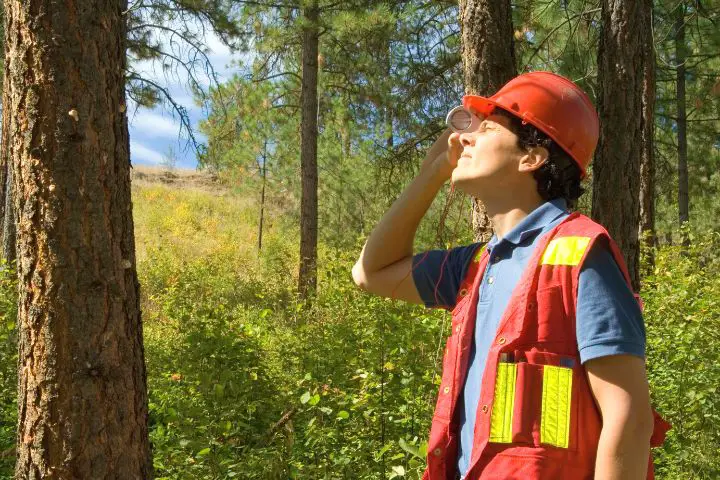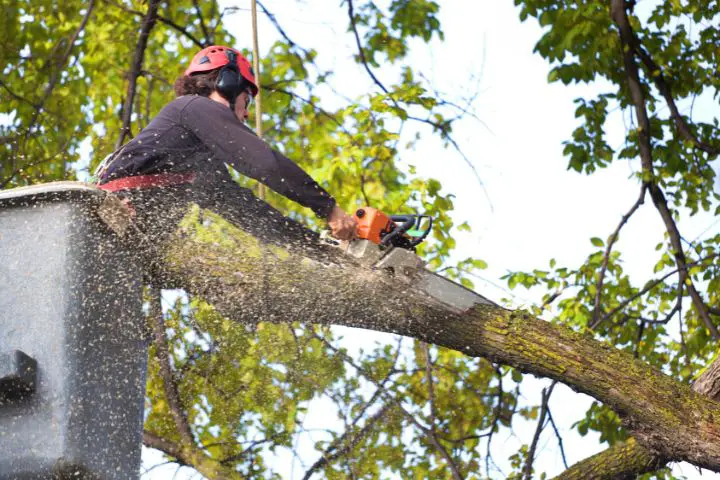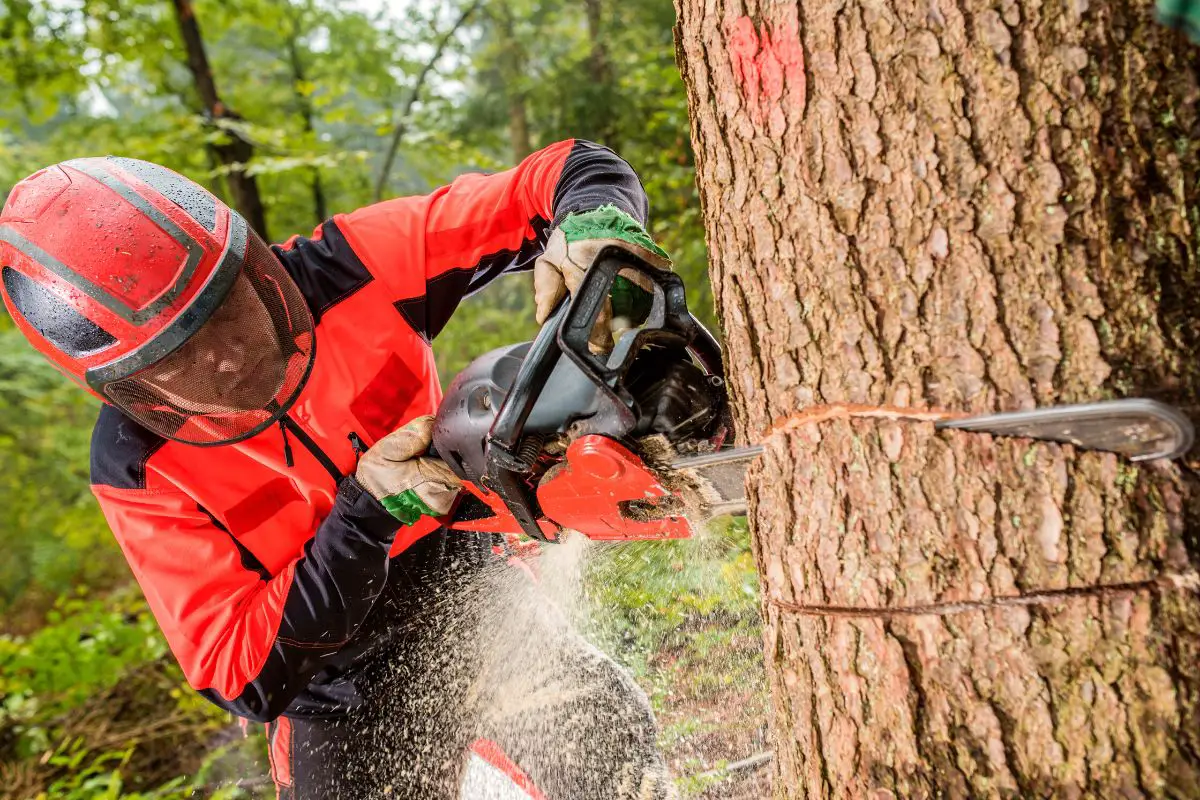Environmental Benefits of Tree Cutting | Yes, they exist + How to Do It Safely
Trees provide many benefits to the environment, including reducing energy usage, cleaning the air, and providing habitat for wildlife. When most people think of tree cutting, they imagine a dangerous and destructive process. However, when done correctly, tree cutting can be a safe and environmentally friendly way to improve your property. This article will discuss the environmental benefits of cutting trees. Additionally, it will explain how to cut down a tree safely and correctly. Continue reading to learn more.
Related Article: Is bamboo eco-friendly (more sustainable than wood)?
Benefits of Cutting Trees
1. Reduces the Risk of Falling Trees
Cutting trees can help avoid the potential risks associated with them falling and causing damage. Over time, by natural aging or simply due to a season of extreme weather, trees can become unstable, weaken and become hazardous, making them a potential threat to homes and roadway safety.
When cutting trees near a house or road, safety should not be taken lightly. Tree removal involves hazardous activities that require the proper gear and precautions to ensure smooth execution and the safety of those around you. Chainsaw chaps and trousers are an absolute must-have when cutting down a tree. This equipment can help protect anyone involved in the process from any physical harm due to flying debris or other unnatural hazards associated with chopping down trees.
2. Encourages Environmental Diversity
Cutting down trees encourages environmental diversity in many ways. For instance, animals may not have enough space to live comfortably and thrive in an area with too much tree coverage. By cutting down a few trees, the site can become more diverse, allowing for the introduction of new plants and animals that were unable to live there before. The cleared land can also give way to new agricultural production and fuel sources, like wood for heating or cooking.
Furthermore, with fewer trees, more sunlight can reach the ground, helping nearby vegetation to grow bigger and healthier while giving it room to spread. This jostles up the existing environment by increasing biodiversity across species of all kinds. Additionally, this enhanced diversity stabilizes ecosystems, making them more capable of supporting life in low-resource settings.

3. Creates Space to Plant New Trees
Trees can be cut down for many reasons from safety issues to opening up space to plant new ones. For example, trees must be removed from time to time to stop the blaze from spreading in wooded areas prone to wildfires. Others might clear-cut an area to make room for future planting in forestry operations. When done with careful planning and consideration for the environment, selective cutting or thinning can open up land for local ecosystems and create space for farmers to replenish their soils.
Reforestation efforts could then be introduced on cleared plots using carefully chosen seedlings, such as native species that have adapted optimally to these climates as determined by scientists and park rangers. This helps promote biodiversity and ensure more diverse root systems. Cutting down certain trees can also open up light gaps, create firebreaks, and introduce natural disturbance regimes that benefit the ecosystem in the long run without hurting the environment. This is key in environmental management practice today.
4. Reduces the Spread of Diseases and Infestations
Trees can be affected by numerous diseases and infestations, many of which can have devastating effects on the health of a tree. Examples include Dutch elm disease, sudden oak death, and oak wilt, which can affect various species. Trees can contract these diseases from multiple sources, such as bark beetles, sap-feeding insects, and even direct root contact with infected trees.
Cutting down infected trees can help prevent them from further spreading within a particular species and surrounding trees. Furthermore, if the infection is discovered early enough, trimming affected branches or even complete removal can help mitigate the spread. Moreover, it would be best to employ sanitation efforts like removing infected wood and destroying it offsite to guarantee no further contagion occurs. It must be noted that there’s an increasing concern regarding the frequency and magnitude of tree diseases due to changing environmental conditions. Therefore, swift action must be taken to preserve the healthiest trees and the entire forest.
5. For Extraction of Useful Products

Cutting down trees has long been a method for obtaining a wide variety of valuable resources from them, and it can be quite useful to grasp this process. Trees are composed of many different components, such as cellulose, lignin, and hemicellulose, which can be separated after harvesting. These components can then be converted into paper, lumber, furniture, fuel, and more.
In addition to raw materials produced by cutting down trees, there are also many tools and products used in everyday life that are derived from them. Various medicines, perfumes, flavorings, and oils are some of the best-known examples – all of which rely on trees as their fundamental ingredient.
Of course, it’s important that we do this sustainably and responsibly – as there could be very negative impacts deriving from deforestation and land clearing.
How to Cut Down Trees Safely
When cutting down trees, safety should always be your number one priority. Here are the top tips on how to safely cut down trees:
1. Invest in the Right Tools
Investing in the right tools can be essential to cut down trees safely. Good quality saws, axes, and other instruments can provide precise cuts and help prevent injury or other accidents. Professionals who use these tools regularly tend to understand better how to operate them safely and efficiently, drastically reducing the risk of harm or damage to any property in the vicinity. It’s also easier for workers to get the job done quickly without worrying about their safety, as they can confidently rely on their equipment to make clean, safe cuts. Investing in the right tools is an essential step that should not be overlooked when cutting down trees responsibly and getting the job done right.
2. Liaise With a Professional Arborist
Another critical step in learning how to cut down trees safely is to work with a professional certified arborist. These experts have the proper training, experience and knowledge about local tree care regulations that may influence your strategy. They can advise on how to effectively deal with challenging cuts, identify any potential hazards or risks along the way, and help you avoid mistakes that could lead to injury or other unwanted outcomes. For example, if you need assistance determining the best way to take down a large tree safely, an arborist can help assess the situation and advise on how best to proceed.

3. Use Your Chainsaw Properly and Carefully
Chainsaws can be an excellent tool for accomplishing multiple tasks, from cutting down trees to trimming brush. However, it’s essential to use them properly and carefully to ensure safety. Before getting started, you should read and understand the user manual that comes with the chainsaw. Wear clothing made for protection, such as safety goggles, heavy boots, and gloves. Make sure the saw is sharpened correctly and in good working order before using it, and check the throttle response regularly while in operation. When making cuts, stand steady on both feet; don’t reach or hold onto objects while cutting over them. You should also keep your hands away from the saw chain and ensure you know where your saw’s kickback zone is.
4. Establish a Safety Zone
Another vital step in learning how to cut down trees safely is to create and maintain a safety zone around the tree you are working on. This area should be at least 15 feet in each direction from the base of the tree and clear of any bystanders or other potential hazards (including power lines, buildings, or other trees). Once you have created the safety zone, ensure that people and animals are prevented from entering it. This will help prevent accidents or injuries while you work with your chainsaw or use other power tools to cut down the tree.
5. Invest in the Right Safety Gear
Another essential step to cut down trees safely is to invest in the proper safety gear. Safety equipment, such as heavy-duty work gloves, hard hats, eye protection, and steel-toed boots, can help protect you from injury while working with power tools or cutting large tree limbs. Wearing this type of protective gear helps reduce the risk of injury or damage and gives you peace of mind and confidence as you make your cuts.
6. Follow the Right Safety Protocols

Lastly, following the correct safety protocols is essential to learning how to cut down trees safely. This includes awareness of the risks involved, having emergency communication systems in place, and wearing appropriate personal protective equipment (PPE) while cutting down trees. Periodically assessing your safety plan and making necessary changes can help ensure that you remain safe throughout the process.
Conclusion
Cutting down trees safely is an essential skill that needs planning and attention to detail. Following these simple steps, you’ll learn how to cut down trees without risking injury. Whether you’re working on your own or with a team of professionals, it’s crucial to take the necessary precautions and use proper safety gear and equipment throughout the process. With these tips mentioned above, you can feel confident in cutting down trees safely and efficiently.






